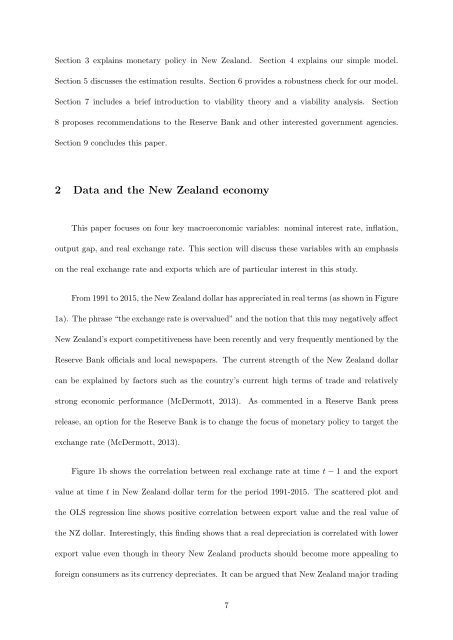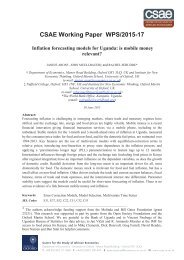Create successful ePaper yourself
Turn your PDF publications into a flip-book with our unique Google optimized e-Paper software.
Section 3 explains monetary policy in New Zealand.<br />
Section 4 explains our simple model.<br />
Section 5 discusses the estimation results. Section 6 provides a robustness check for our model.<br />
Section 7 includes a brief introduction to viability theory and a viability analysis.<br />
Section<br />
8 proposes recommendations to the Reserve Bank and other interested government agencies.<br />
Section 9 concludes this paper.<br />
2 Data and the New Zealand economy<br />
This paper focuses on four key macroeconomic variables: nominal interest rate, inflation,<br />
output gap, and real exchange rate. This section will discuss these variables with an emphasis<br />
on the real exchange rate and exports which are of particular interest in this study.<br />
From 1991 to 2015, the New Zealand dollar has appreciated in real terms (as shown in Figure<br />
1a). The phrase “the exchange rate is overvalued” and the notion that this may negatively affect<br />
New Zealand’s export competitiveness have been recently and very frequently mentioned by the<br />
Reserve Bank officials and local newspapers. The current strength of the New Zealand dollar<br />
can be explained by factors such as the country’s current high terms of trade and relatively<br />
strong economic performance (McDermott, 2013).<br />
As commented in a Reserve Bank press<br />
release, an option for the Reserve Bank is to change the focus of monetary policy to target the<br />
exchange rate (McDermott, 2013).<br />
Figure 1b shows the correlation between real exchange rate at time t − 1 and the export<br />
value at time t in New Zealand dollar term for the period 1991-2015. The scattered plot and<br />
the OLS regression line shows positive correlation between export value and the real value of<br />
the NZ dollar. Interestingly, this finding shows that a real depreciation is correlated with lower<br />
export value even though in theory New Zealand products should become more appealing to<br />
foreign consumers as its currency depreciates. It can be argued that New Zealand major trading<br />
7





